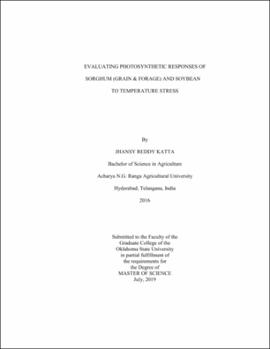| dc.description.abstract | Physiology, growth and development of crop plants are driven by temperature and temperatures either side of the optimum lead to temperature stress. The objective of this research was to quantify the effect of temperature stress on gas exchange and chlorophyll fluorescence parameters of grain sorghum, forage sorghum, and soybean. An experiment was conducted using six walk-in growth chambers in Controlled Environment Research Facility at Oklahoma State University. Plants in growth chambers were subjected to six different temperatures (20/12, 24/16, 28/20, 32/24, 36/28, and 40/32 degrees C). Plants of grain sorghum hybrid Midland Genetics 4772, forage sorghum var. Ross Elite or Surpass BMR and soybean MG 3926 NRS2 were used respectively for grain sorghum, forage sorghum, and soybean respectively. Leaf level parameters were recorded with the help of LI-6400 instrument fitted with leaf chamber fluorometer (LCF), that provides LED-based fluorescence and irradiation, beginning at 45 days after planting. Response to temperature of photosynthesis, transpiration, electron transport rate and chlorophyll fluorescence were studied. Both light and CO2 response curves were measured using the automated software in the instrument. The parameters derived from the curves are further evaluated with response to temperature. The rates of photosynthesis declined as the growing temperatures increased in soybean while the transpiration rates were increased. The responses of photosynthesis to both light and internal CO2 suggested that photosynthetic rates of grain and forage sorghum acclimate to high temperature through an increased rate of electron transport. The photosystem 2 (PSII) values also remained unaffected at high temperatures suggesting there is no damage to photosynthetic machinery. In conclusion, the measured photosynthetic parameters demonstrated that sorghum and soybean tolerate high temperatures under irrigated conditions. The temperature functions can be used to improve leaf level functions in the mechanistic models of sorghum and soybean. | |
